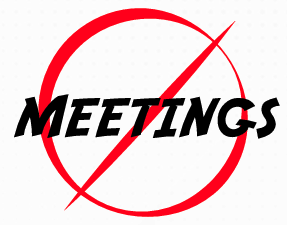Guiding board meetings to maximise productivity
The secret ingredient to productivity? Ban daily meetings! A 2022 study released by a business management school in the US revealed that companies can increase their productivity by up to 73% if they put in place a policy that bans meetings three days a week. The remedy for productivity is to remove superfluous meetings that disrupt decision-making. With workers spending more than 85% of their time in meetings, it is no wonder that productivity is neither consistent nor predictable.
A McKinsey survey showed that 61% of executives expressed dissatisfaction with the effectiveness of decision-making processes, particularly during meetings. These executives reported that a significant portion of their time, potentially more than half, was spent in unproductive meetings that did not contribute to decision-making effectively.
Another survey by the consulting firm found that 80% of executives were considering or already implementing changes in meeting structure and cadence in response to the evolution in how people work during the pandemic. The reality is that effective time spent in meetings ultimately leads to better decisions. Better decision making drives key performance indicators (KPIs), future strategy and long-term growth. So, how can you make the most of something that is integrated and essential to the workflow and structure anyway? How do you increase high-value collaboration and essentialise the available time?
What is the guiding thread for maximising productivity in board meetings?

Establishing clear objectives for each board meeting is crucial to maximising productivity. This ensures that all participants understand the purpose of the gathering and can come prepared with relevant input, ultimately leading to better decision-making and more effective outcomes. To achieve this, consider implementing the following methods:
- Identify key priorities and goals before each meeting
Prioritise topics by identifying KPIs that need attention or areas where progress has been slow. Once these priorities are set, share them with board members in advance so they can prepare accordingly. - Align objectives with the purpose, mission and vision of your organisation Keep discussions centred around driving long-term success rather than being distracted by unnecessary matters.
By setting clear objectives and aligning them with your company’s mission, you will be able to guide productive board meetings that drive meaningful progress towards your goals.
As Brett Herkt, Founder and CEO of BoardPro, points out, “Often board members arrive at board meetings and management CEOs forget that the context has switched from their day job. I believe good CEOs constantly put that vision, purpose, strategy statement in front of the board members when they are reporting and doing progress reviews, just to keep that context fresh all the time. And one of the things I’ve really enjoyed observing while weve been doing this webinar series is that the good operators are always talking about achieving that purpose, that vision and everything being in support of that.”

- Should this even be a meeting?
Recurring meetings often deviate from their original purpose and become less focused. Assess the frequency of these meetings by consulting stakeholders to determine if adjustments, such as changing from weekly to monthly, would be beneficial. In addition, consider whether decisions could be made by individuals with guidance effectively rather than relying solely on meetings – this, of course, is dependent on the company culture and whether it encourages individual decisionmaking or rather promotes a meeting-centric collective approach. - What concrete outcomes do I want from this meeting?
Always remind yourself of the purpose. Articulate it and pursue it. - What is the role of each member that is attending? Who is the decider? Accountability is key in speeding up decision-making. Meetings should take place only after the roles are set in place. In today’s fast-paced and competitive environment, the lack of clear accountability can be particularly costly as speed and agility become crucial factors for gaining a competitive edge.
Create structured agendas
A well-structured agenda helps guide productive board meetings by outlining specific discussion points beforehand. Be sure to include time allocations for each topic as well as any necessary pre-read materials.
- Distribute agendas ahead of time
Providing ample time for board members to review the agenda before the meeting allows them to arrive informed about items up for discussion, which promotes efficient use of everyone’s time during meetings. - Maintain focus during discussions
Encourage people to stick to the predetermined talking points while discouraging side conversations or unrelated tangents that may derail productivity. - Evaluate and adjust
After each meeting, assess what worked well and identify areas for improvement. This continuous evaluation process will help ensure future strategies are even more effective.
Meeting productivity can be further enhanced by incorporating board management software, such as BoardPro, which allows for easy agenda creation and time allocation. This helps ensure that all board members are aware of the meeting’s structure and can prepare accordingly.
Creating structured agendas ensures that board meetings are focused on the most important topics and provides a roadmap for productive discussions. In addition, promoting dialogue and engagement between board members can cultivate a cooperative atmosphere, ultimately leading to improved outcomes.
Time Management
Renowned business author and McKinsey alumnus Tom Peters says that “the only thing on Earth that never lies to you is your calendar; that is why I’m a fanatic on the topic of time management. But when you use that term, people think, ‘Here’s an adult with a brain. And he’s teaching time management. Find something more important, please.’ But something more important doesn’t exist.” Unstructured time and diffuse meetings are avoided with proper preparation. It can be described as a virtuous or vicious cycle: good time management is directly proportional to effective meetings, and bad time management to inefficient meetings.
Essentially, good time management correlates with more empowerment, even turning down those unnecessary meetings – and better meetings mean that you can feel more purposeful in cracking on with your work.
Encourage open communication and participation
Fostering an environment where open communication is encouraged allows every member’s voice to be heard, which results in more informed decisions being made collectively. Active participation from all attendees leads to a stronger sense of collaboration and increased efficiency during discussions. By implementing the following strategies, you can ensure that your board meetings are productive and inclusive:
- Facilitate constructive debates among Board members
Create opportunities for healthy debates by encouraging members to share their opinions on key topics openly. - Ensure equal opportunities for everyone to contribute their insights:
To maximise meeting productivity, it’s essential that everyone feels comfortable sharing their ideas and expertise with the group. Encourage people who may be hesitant or shy about speaking up by creating an atmosphere of trust and respect within the boardroom. You might also consider assigning specific roles or tasks during meetings (e.g, note-taking or leading discussion) so that board members feel more involved in the process.
Other critical elements you can incorporate to maintain focus and ensure productivity are:
- Promote active listening
Emphasise the importance of active listening among board members; this helps create an environment where everyone feels valued and respected when they speak. - Avoid side conversations
Ensure that all participants stay focused on the topic at hand by discouraging side conversations during meetings - these distractions not only disrupt proceedings but also hinder overall productivity. - Incorporate technology
Utilise board management software to streamline communication and collaboration, making it easier for members to stay engaged and contribute effectively.
Technology in the boardroom
Technology furthers engagement. In the current dynamic and uncertain environment, technology enables more focus and more agile and efficient execution.
Digital transformation has grown during the COVID-19 pandemic, with 85% of CEOs accelerating digital initiatives, and according to Deloitte’s global automation survey 2020, 73% of executives said they are pursuing intelligent automation for their business, up from 58% in 2019. The Deloitte survey revealed a gap between the growing demand for more tech understanding and engagement and what’s currently being provided by boards.
An easy way to keep your board on track is to incorporate board portal software into your meetings. Board software – like BoardPro’s system – helps streamline board meetings for members, assisting with cumbersome tasks such as like meeting minutes and meeting agendas. It frees up board members so that you have time to focus on the real issues at hand.
The board’s role with respect to technology needs to be centred on the long-term future-proofing of competitiveness in an increasingly digital world. The board must help management strike the appropriate balance between near-term results and long-term growth and competitive advantage.”
Rich Nanda
Principal at Deloitte Consulting LLP.
Tech fluency can help bridge the gap and develop a Board’s productivity:
- Automate your decision-making when you can and when time counts.
- Provide board members with more education technology trends.
- Recruit more board members with technology expertise.
A recent PwC survey showed that up to 43% of board members find virtual meetings to be less engaging than in-person discussions. Learn to adapt and create a balance between virtual and physical meetings by communicating with your team and observing the best tactics for your board.
In an article entitled “Why technology is the strategic issue of our time”, the authors share that the influence and impact of disruptive technologies is the strategic issue of our time. Regardless of what industry you are in, or what parts of the company you manage technology can enhance and amplify what you do. Waiting to see how things shake out or delegating all technology issues to the chief information officer (CIO) is no longer a viable option for today’s chief executive officers (CEOs) and their teams.”
In an article entitled “Why technology is the strategic issue of our time”, the authors share that the influence and impact of disruptive technologies is the strategic issue of our time. Regardless of what industry you are in, or what parts of the company you manage technology can enhance and amplify what you do. Waiting to see how things shake out or delegating all technology issues to the chief information officer (CIO) is no longer a viable option for today’s chief executive officers (CEOs) and their teams.”
Enhancing productivity, speed and innovation in any organisation is achievable through high-quality and focused interactions, ultimately leading to improved business performance. We trust that the above insights have provided inspiration for exploring novel techniques to enhance the effectiveness and efficiency of collaboration within your board.
Remember that every board is different, and success takes many forms. Adhering to best practices and strategies can assist boards in prioritising crucial objectives and making the best use of the limited time of board members.
If you're looking for a tool to streamline your Board processes, check out BoardPro - an all-in-one software solution designed specifically for Boards!
Schedule a demo with our team today and begin to experience a whole new way of meeting.
Share this
You May Also Like
These Related Stories

What type of director are you?

What does good conflict and lousy conflict look like in the boardroom?
.jpg)


